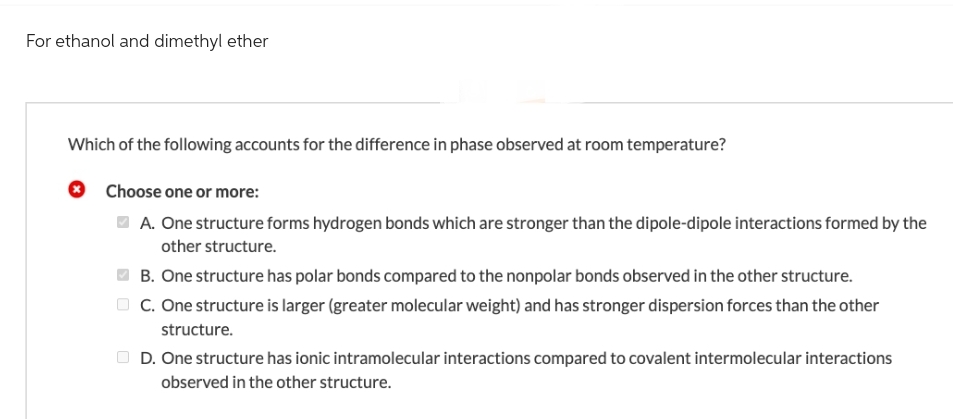For ethanol and dimethyl ether Which of the following accounts for the difference in phase observed at room temperature? Choose one or more: A. One structure forms hydrogen bonds which are stronger than the dipole-dipole interactions formed by the other structure. X B. One structure has polar bonds compared to the nonpolar bonds observed in the other structure. C. One structure is larger (greater molecular weight) and has stronger dispersion forces than the other structure. D. One structure has ionic intramolecular interactions compared to covalent intermolecular interactions observed in the other structure.
For ethanol and dimethyl ether Which of the following accounts for the difference in phase observed at room temperature? Choose one or more: A. One structure forms hydrogen bonds which are stronger than the dipole-dipole interactions formed by the other structure. X B. One structure has polar bonds compared to the nonpolar bonds observed in the other structure. C. One structure is larger (greater molecular weight) and has stronger dispersion forces than the other structure. D. One structure has ionic intramolecular interactions compared to covalent intermolecular interactions observed in the other structure.
Introductory Chemistry: A Foundation
9th Edition
ISBN:9781337399425
Author:Steven S. Zumdahl, Donald J. DeCoste
Publisher:Steven S. Zumdahl, Donald J. DeCoste
Chapter14: Liquids And Solids
Section: Chapter Questions
Problem 38QAP: Two molecules that contain the same number of each kind of atom but [hat have different molecular...
Related questions
Question
G.28.

Transcribed Image Text:For ethanol and dimethyl ether
Which of the following accounts for the difference in phase observed at room temperature?
Choose one or more:
A. One structure forms hydrogen bonds which are stronger than the dipole-dipole interactions formed by the
other structure.
B. One structure has polar bonds compared to the nonpolar bonds observed in the other structure.
C. One structure is larger (greater molecular weight) and has stronger dispersion forces than the other
structure.
D. One structure has ionic intramolecular interactions compared to covalent intermolecular interactions
observed in the other structure.
Expert Solution
This question has been solved!
Explore an expertly crafted, step-by-step solution for a thorough understanding of key concepts.
This is a popular solution!
Trending now
This is a popular solution!
Step by step
Solved in 4 steps with 1 images

Knowledge Booster
Learn more about
Need a deep-dive on the concept behind this application? Look no further. Learn more about this topic, chemistry and related others by exploring similar questions and additional content below.Recommended textbooks for you

Introductory Chemistry: A Foundation
Chemistry
ISBN:
9781337399425
Author:
Steven S. Zumdahl, Donald J. DeCoste
Publisher:
Cengage Learning

Principles of Modern Chemistry
Chemistry
ISBN:
9781305079113
Author:
David W. Oxtoby, H. Pat Gillis, Laurie J. Butler
Publisher:
Cengage Learning

Chemistry: Principles and Reactions
Chemistry
ISBN:
9781305079373
Author:
William L. Masterton, Cecile N. Hurley
Publisher:
Cengage Learning

Introductory Chemistry: A Foundation
Chemistry
ISBN:
9781337399425
Author:
Steven S. Zumdahl, Donald J. DeCoste
Publisher:
Cengage Learning

Principles of Modern Chemistry
Chemistry
ISBN:
9781305079113
Author:
David W. Oxtoby, H. Pat Gillis, Laurie J. Butler
Publisher:
Cengage Learning

Chemistry: Principles and Reactions
Chemistry
ISBN:
9781305079373
Author:
William L. Masterton, Cecile N. Hurley
Publisher:
Cengage Learning


Chemistry: An Atoms First Approach
Chemistry
ISBN:
9781305079243
Author:
Steven S. Zumdahl, Susan A. Zumdahl
Publisher:
Cengage Learning

Chemistry
Chemistry
ISBN:
9781305957404
Author:
Steven S. Zumdahl, Susan A. Zumdahl, Donald J. DeCoste
Publisher:
Cengage Learning